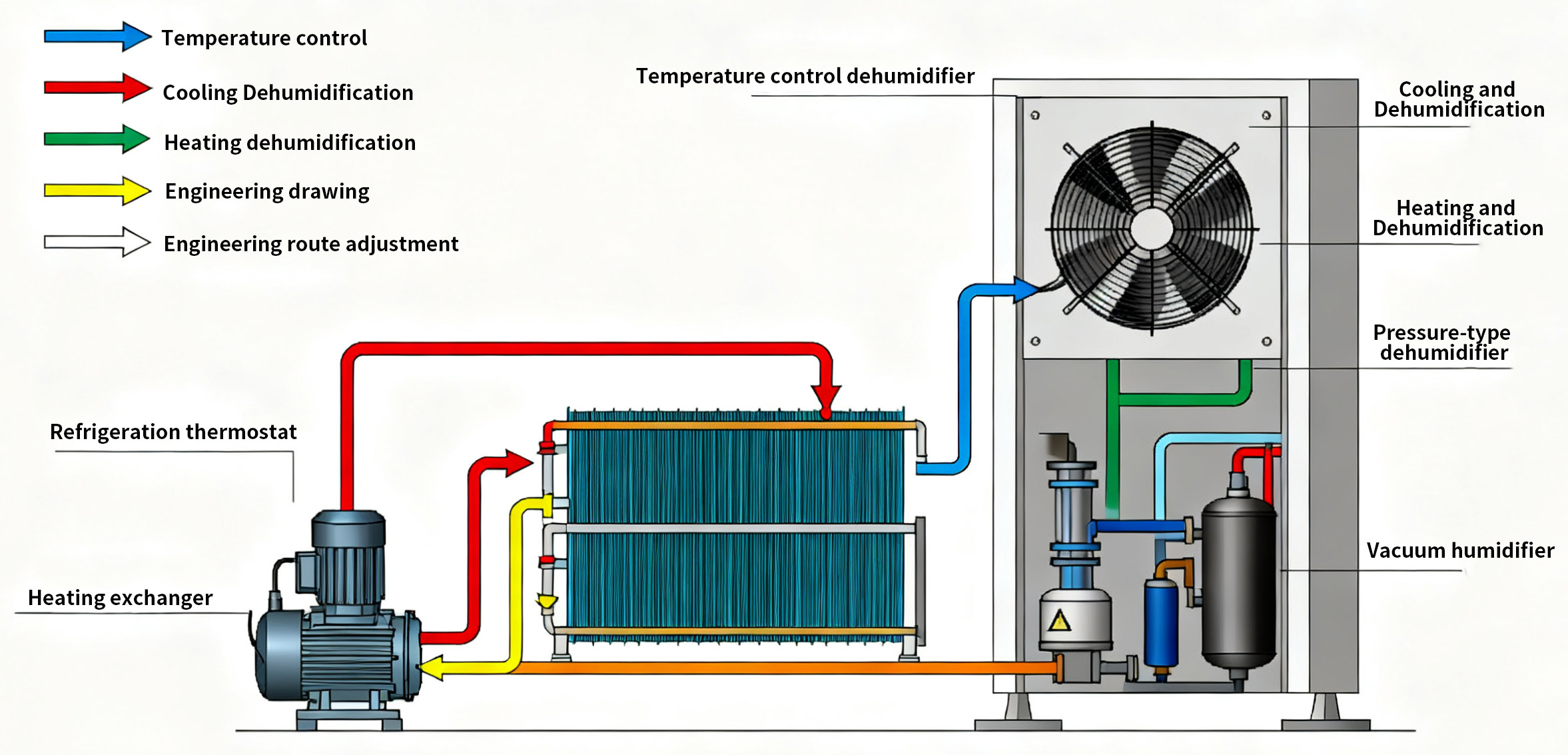


In industrial production, controlling environmental temperature and humidity is critical. Traditional dehumidifiers often fall short
when confronting complex industrial environments, whereas temperature-controlled dehumidifiers perfectly resolve these pain points.

Chapter 1: Understanding Temperature-Controlled Dehumidifiers—More Than Just Dehumidification
Core Issue: Limitations of Traditional Dehumidifiers
In many industrial settings, conventional refrigerant-based dehumidifiers suffer from an inherent flaw: while removing moisture
through cooling, they significantly lower the supply air temperature. This creates two problematic scenarios: first, spaces become
increasingly cold during dehumidification, impacting processes or personnel comfort; second, heating systems must be activated
to maintain temperature, resulting in the energy inefficiency of “cooling and heating simultaneously” and driving up operational costs.
Solution: What is a Temperature-Controlled Dehumidifier?
A temperature-controlled dehumidifier, also known as a constant-temperature dehumidifier, is a high-efficiency environmental
control device integrating dehumidification, cooling, and heating functions. Its revolutionary feature lies in its ability to independently
or synergistically control both temperature and humidity based on actual needs, achieving precise, energy-efficient temperature
and humidity management. It is not merely a “dehumidifier” but a complete “air handling hub.”
Chapter 2: Core Technology Revealed: How Does “Dual Temperature-Humidity Control” Work?
The intelligence of temperature-humidity dehumidifiers stems from the coordinated operation of their core components.
Key Components:
Dual Condenser Design: This is the cornerstone of “dual temperature-humidity control.” One condenser (functioning as a
reheat condenser) recovers heat generated by the system, while the other (acting as a conventional condenser) discharges
excess heat to the outside environment.
Three Core Operating Modes:
Cooling Dehumidification Mode: Ideal for summer or high-temperature/high-humidity environments. The unit functions
as a high-efficiency dehumidifier, lowering air temperature while removing moisture.
Heating Dehumidification Mode: Suited for rainy seasons or low-temperature conditions. During dehumidification, the
unit reheats cooled air using recovered system heat, delivering dry, warm air to prevent space temperature drop.
Temperature-Stabilizing Dehumidification Mode: Ideal for locations demanding extreme temperature stability. Through
precise calculations and component coordination, the system dynamically balances cooling and heating generated during
dehumidification. This ensures the outlet air temperature remains virtually identical to the return air temperature, achieving
efficient dehumidification with minimal impact on ambient temperature.
Chapter 3: Does My Workshop Need It? Primary Application Scenarios
If your production or storage environment has specific temperature and humidity requirements, a temperature-controlled
dehumidifier is likely essential.
Precision Manufacturing: In precision casting workshops, the drying process of molds is highly sensitive to temperature
and humidity. A stable environment ensures uniform drying quality, prevents mold cracking, and significantly reduces
product scrap rates.
Pharmaceutical & Food Industries: Consistent temperature and humidity are vital for drug production/storage, food drying,
and packaging to maintain active ingredient stability and product hygiene, meeting GMP and other regulatory standards.
Specialized Storage: Archives, tobacco warehouses, tea storage facilities, cold chain logistics transition zones, etc. These units
effectively prevent mold growth, moisture damage, and condensation caused by extreme temperature fluctuations, safeguarding
valuable assets.
Underground and Special Facilities: Such as civil defense projects, subway stations, underground garages, and hydroelectric
power stations. These locations are typically humid, and temperature-controlled dehumidifiers can effectively address moisture
and corrosion issues, ensuring facility safety and personnel health.
Chapter 4: How to Select? Focus on These Points
Faced with diverse products on the market, how do you choose a suitable temperature-controlled dehumidifier? Consider the following:
Determine Core Requirements: Dehumidification Capacity
This is the primary step in selection. Dehumidification capacity should not be chosen arbitrarily but requires professional calculation.
Comprehensive factors include:
Workshop Area and Ceiling Height: Determines the total space volume.
Target Humidity: The range within which you wish to control environmental humidity.
Initial humidity and environmental sealing: Local climate, indoor water sources, and door/window seals all impact load requirements.
Consult professionals to calculate the precise required dehumidification capacity (unit: kg/h) through detailed analysis. This prevents
oversizing (wasteful) or undersizing (ineffective) units.
Evaluate Energy Efficiency and Smart Management
Energy Efficiency Ratio (EER): Opt for high-efficiency, energy-saving models. Though initial costs may be slightly higher, long-term
operation yields significant electricity savings.
Smart Control Systems: Modern industrial equipment should support IoT remote monitoring. Centralized management of multiple
units via mobile or computer platforms—enabling real-time operation data viewing, parameter adjustments, and fault alerts—greatly
enhances management efficiency and system reliability.
Chapter 5: Summary
Industrial temperature-controlled dehumidifiers transcend traditional dehumidification concepts. Through advanced heat pump and smart
control technologies, they achieve precise, independent regulation of both “temperature” and “humidity” dimensions in industrial environments.
Not only do they resolve issues like temperature fluctuations and high energy consumption associated with conventional dehumidification
methods, but they also serve as powerful tools for ensuring product quality, enhancing manufacturing processes, and protecting stored
materials and critical infrastructure. Understanding their operating principles, identifying suitable application scenarios, and conducting
scientifically informed selection will be a crucial step in creating a stable, efficient, and energy-saving industrial environment.